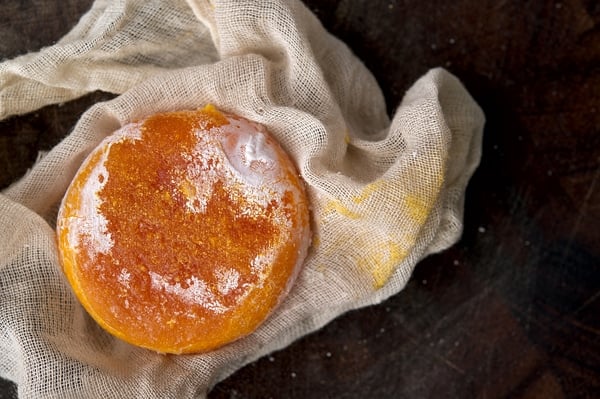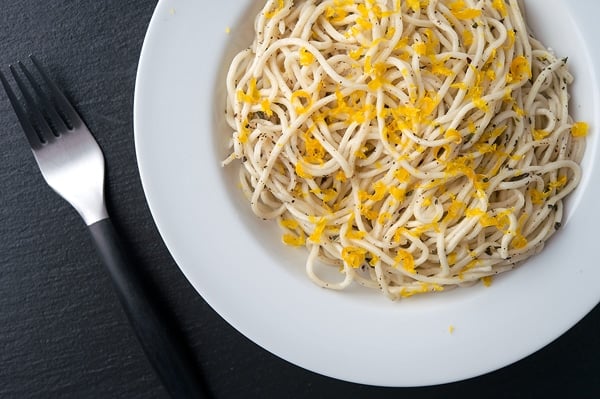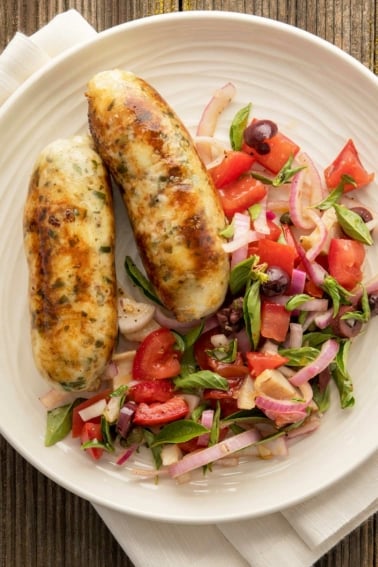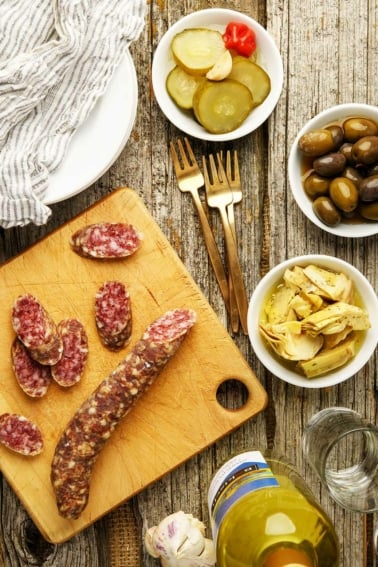As an Amazon Associate I earn from qualifying purchases.

Egg yolks are one of the most magical of foods. Chefs all over the world wax poetic about them, but it’s hard to understand why when all you might be exposed to are the wan, watery, factory-farmed yolks you see in most supermarkets. A golden treasure they are not.
You can only understand the joy — lust, even — over an egg when you finally see (and taste) a real egg, eggs from chickens raised on grass and bugs and whatever else it is that a hen loves to nibble throughout the day.
Before I’d encountered such eggs, when I saw pictures of Italian egg pasta, I thought they were retouched: Their pasta is always bright yellow. As much as I tried, I found it impossible to duplicate with eggs from the supermarket. I talked to Italian pasta makers and they said you need yolks of a truly golden, almost orange, hue. That’s what gives you that pretty color.
I came into possession of such eggs from my friend Teala’s father, who raises ducks and geese in my neighborhood. It’s what I prefer to use for my pasta, and, just like the Italian pasta pictures I swooned over, the photos on this post are not retouched. This is precisely how yellow they actually are.
Not too long ago, Teala’s dad gave me two goose eggs along with the duck eggs. I was amazed at their size. I cracked one open and made an entire batch of pasta with that one egg. I was shocked at how orange the yolk was — brighter even than the duck eggs.
I wanted to capture that color, that richness. I’d known about salt cured egg yolk for a few years; my friends, Chefs Brad Cecchi and Oliver Ridgeway at Grange in downtown Sacramento had first clued me into it. Basically you bury egg yolks in salt, then dry them out until they are like a very hard cheese. This is exactly how you use them — as a golden, eggy, über rich substitute for grated cheese over pasta or rice.
Brad and Oliver never explained to me exactly how to do this, but fortunately Chef Jeffrey Weiss does in his remarkable book Charcutería: The Soul of Spain. You will be seeing a lot of this book in the months to come. I am mildly obsessed with it and have already made a half-dozen or so of its recipes, ranging from salami to sausages to cured fish and now, here, salt cured egg yolks.
If you’ve never cured anything in your life, this would be a good place to start. It’s really easy and comes together in about 2 weeks. And once you’ve made the cured yolks, you can use them over pasta for months.
What else can you do with cured egg yolk? Not sure. I eat a lot of pasta. What would you suggest?

Grate your egg yolks over any of these pasta recipes.
Salt Cured Egg Yolk
Ingredients
- Egg yolks
- Salt
- Cheesecloth
Instructions
- Get yourself two containers: One for the whites, so you can do something with them later, and one to cure the yolks. You will need to lay down a half-inch layer of kosher salt in the bottom of your curing container; you can go a little deeper if you want. Make little depressions in the salt to hold the egg yolks.
- Crack the eggs and separate them. Gently lay the yolk in one of the depressions and repeat until you have all your eggs in the container. Now bury them in more salt.
- Keep the yolks buried in the salt for a week in the refrigerator. Take them out -- the yolks will be firm and a little tacky still -- and carefully brush off the salt. You might need to remove the salt with a damp paper towel.
- Wrap the yolks loosely in cheesecloth and hang them in the fridge until they are dry, about 7 to 14 days. Store in the cheesecloth in a closed container in the fridge.
Notes
Nutrition information is automatically calculated, so should only be used as an approximation.





Got this in the works. This couldn’t be simpler and I can’t wait to hear the comments from the family regarding the little cheesecloth balls hanging in the fridge. Thanks so much for all the cool and rewarding recipes!
Think it would work with ostrich eggs?
This is fantastic. I can’t wait to try this. What is the texture and consistency of the cured eggs like? Could they be sliced or would they crumble. If they crumbled I think they would make a cool addition to a salad. If they could be sliced then I’d serve them with charcuterie.
Hi Hank,
What a great insight. We cure a lot of things at The El Dorado Meat Collective but haven’t yet cured egg yolks. We usually buy duck and goose eggs from our local co-op or direct from local farms…chicken eggs too. I can no longer cook with the thin, watery, flavorless yolks of the mainstream grocery store – and agree that the color is only the tip of the iceberg with good eggs, far more nutrition, much richer taste, and much better texture in cooking.
Not sure, but I’m thinking that the cured yolks would still add a “custard-like” consistency to any sauces you add it to, along with the more concentrated flavor and salt. Of course, you can use fresh eggs for the consistency, but I think I’m going to play around with it and see what new recipes I can come up with.
Thanks!
Crystal & Jon
This reminds me of the salted eggs and egg yolks (usually duck) used in Chinese cooking.
As for uses, how about grated into pierogi filling?
For brhau/Hank Shaw,
I had the same thought about bottarga. Has anyone tried combining salt-cured egg yolks and bottarga with melted butter grated over spaghettini?
Ward Horack
London
In response to Allan about Ag methods, and speaking as a veterinarian: Ag methods absolutely DO make a difference in yolk quality, and overall egg quality in addition. there has been enough research comparing the content of wild and truly pastured eggs compared to caged, commercial fed chicken eggs to show that.
Vit E, Omega 3,6,9 fatty acid ratios, Vit A and beta-caroteine, B-vits, as well as other nutrients are far better in truly pastured eggs. Also, seeds and grains don’t provide a lot of carotenoids. vegetable matter and insect parts do. Yes, one can feed marigold extract to chickens, one might get darker yolks (I’ve haven’t seen research on that). but that does not necessarily reflect higher nutritional quality.
That is SO cool! Thanks! Something fermented I can easily do at home, and it makes so much sense — yolks are basically the ‘milk’ or ‘cheese’ of fowl. I bet it tastes amazing, too. Wow, i’m floored. So much to discover of the food in other cultures, i doubt there is anything that hasn’t already been done somewhere! Thanks again for this (and sorry for the gushing 😉
jg
The color in the yolks is due to the volume of carotenoids the chicken eats. Wild chickens get this from bugs and seeds, and it would make sense that ducks and geese have yellower yolks than chickens – the same way flamingos turn pink from eating shellfish.
In most modern agriculture, the volume of carotenoids is precisely controlled and measured. It’s primarily consumer preference across countries, not difference in agriculture methods. If you’re raising chickens, you can add marigold extract to their feed to get that same dark golden color.
Thanks Hank!
I have so many duck eggs I don’t know what to do with them all and my two African Geese give my about four eggs a week this time of year.
Cheers!
This reminds me of the chicken “bottarga” at State Bird, which is also smoked. I will definitely try this!
MFree and Mikio: I am sure they will be fine if they are barely touching, but not so sure about making a block out of mixed yolks. The reason is because when you do that, the yolk will seep into the salt and not stay as a cohesive mass. I’d stick to unbroken yolks.
Teala: Yes. In the fridge.
I knew you’d do something wicked cool with the goose eggs!!! When the eggs are curing in the salt, do you keep them in the fridge or???
Does the external barrier of the yolk need to be intact, or could i maybe put multiple chicken yolks into some sort of combined chunk (salt mold?) to make a bigger block? Hope that made sense.
Lovely.
FYI, I have seen duck eggs (often) and goose eggs (not so often) in our local Asian market.
This is brilliant! Such a great way to preserve eggs as well, when my chickens are laying heavily. Make meringues with the egg whites. 🙂
Is it okay if the yolk are touching while curing? Or do we need a large enough container to keep them separate?
Brilliant way to magically transform egg yolks!
Lou: I don’t think so because they are hard, like pecorino cheese.
Fratello,
Can use them in place of yolks in recipes (taking salt into consideration, obviously)?